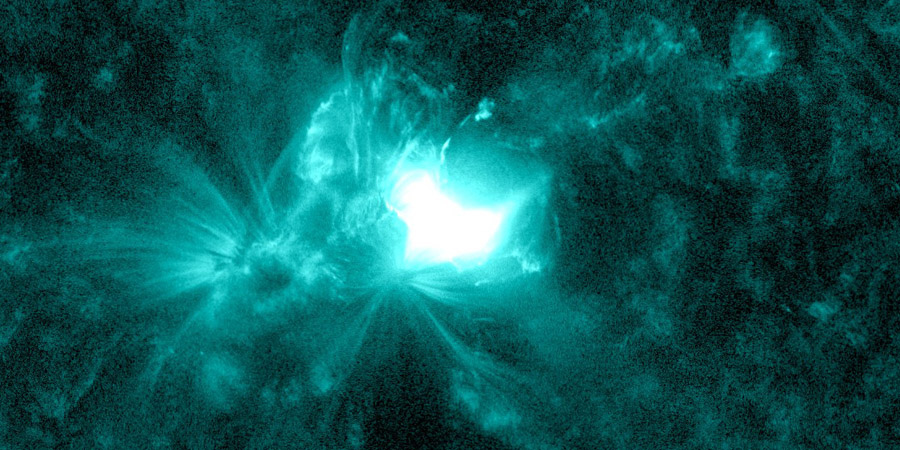M1.6 solar flare, G2 storm watch
Sunday, 10 October 2021 15:17 UTC

An M1.6 solar flare peaked yesterday at 06:38 UTC. Source of the eruption was sunspot region 2882 which was in an earth-facing position at the time. Type II and IV radio sweeps were observed which suggested straight away that the event should be eruptive and thus launch a coronal mass ejection towards Earth. When coronagraph imagery became available, it became quickly obvious that the solar flare indeed launched a coronal mass ejection towards our planet.
A preliminary look at the eruption from the M1.6 solar flare with the help of SDO and STCE/SIDC.
— SpaceWeatherLive (@_SpaceWeather_) October 9, 2021
We see a gorgeous eruption which very likely launched an earth-directed CME into space. More info will come later when coronagraph imagery becomes available. pic.twitter.com/1aCUAQGILK
A fantastic full halo coronal mass ejection became visible as seen by SOHO/LASCO, the coronagraph imager watching coronal mass ejections as they leave the Sun as seen from Earth's perspective. The gorgeous full halo signature shows us the expanding cloud as it travels away from the Sun, towards Earth. There is not a shadow of a doubt that this cloud of solar plasma will arrive at Earth. The only question is when will it arrive and how strong will the geomagnetic storm become?
Coronagraph imagery is starting to trickle in showing the impressive CME launched during the M1.6 solar flare.
— SpaceWeatherLive (@_SpaceWeather_) October 9, 2021
A full halo CME was launched which will certainly arrive at Earth within the next 48 to 72 hours. Geomagnetic storm conditions will be highly likely. More info later, pic.twitter.com/wURl4YHYf4
The American space weather service, the NOAA SWPC expects the M1.6 coronal mass ejection to arrive after midday UTC tomorrow, Monday 11 October while the European SIDC goes with an impact time of 20 UTC or later. We go along with the SIDC and think an arrival time during the UTC evening hours before midnight seems very reasonable. A moderate G2 geomagnetic storm watch (Kp6) has been issued by the SWPC and is in effect for tomorrow, 11 October with a minor G1 geomagnetic storm watch (Kp5) being in effect for Tuesday, 12 October. Under optimal conditions, aurora might become visible from latitudes like Tasmania in Australia, Scotland, southern Sweden and the Baltic states. The northern states in the USA should also stay alert as they approach nightfall in case we do get the expected geomagnetic storm conditions. The coronal mass ejection passage could be followed by the onset of a coronal hole solar wind stream so we are in for a couple of interesting days early next week!
The NOAA SWPC expects the M1.6 CME to arrive after midday tomorrow, Monday 11 October.
— SpaceWeatherLive (@_SpaceWeather_) October 10, 2021
A moderate G2 (Kp6) geomagnetic storm watch is in effect for tomorrow evening. CME effects should persist into Tuesday, 12 October and could be followed by the onset of a coronal hole stream. pic.twitter.com/Fw5CAQeRV1
Thank you for reading this article! Did you have any trouble with the technical terms used in this article? Our help section is the place to be where you can find in-depth articles, a FAQ and a list with common abbreviations. Still puzzled? Just post on our forum where we will help you the best we can!
Latest news
Latest forum messages
Support SpaceWeatherLive.com!
A lot of people come to SpaceWeatherLive to follow the Sun's activity or if there is aurora to be seen, but with more traffic comes higher server costs. Consider a donation if you enjoy SpaceWeatherLive so we can keep the website online!

Space weather facts
| Last X-flare | 2025/02/23 | X2.0 |
| Last M-flare | 2025/03/11 | M1.1 |
| Last geomagnetic storm | 2025/03/12 | Kp5 (G1) |
| Spotless days | |
|---|---|
| Last spotless day | 2022/06/08 |
| Monthly mean Sunspot Number | |
|---|---|
| February 2025 | 154.6 +17.6 |
| March 2025 | 116.4 -38.2 |
| Last 30 days | 141.1 -6.3 |


